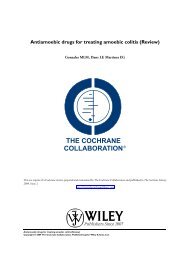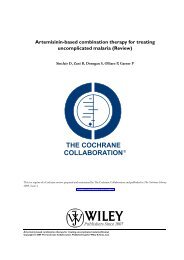Topical treatments for fungal infections of the skin and nails of the foot.
Topical treatments for fungal infections of the skin and nails of the foot.
Topical treatments for fungal infections of the skin and nails of the foot.
Create successful ePaper yourself
Turn your PDF publications into a flip-book with our unique Google optimized e-Paper software.
(a) <strong>skin</strong> - maintenance <strong>of</strong> cure 12 weeks after initiation <strong>of</strong> intervention.<br />
Clotrimazole four weeks versus clotrimazole one week<br />
In a trial comparing 4 weeks <strong>of</strong> 1% clotrimazole with 1 week <strong>of</strong><br />
1% clotrimazole Bergstresser 1993 found a statistically significant<br />
relative reduction in treatment failure <strong>of</strong> 53% favouring <strong>the</strong> longer<br />
treatment time (RR at 12 weeks 0.47, 95% CI 0.28 to 0.78;<br />
Analysis 5.4).<br />
Terbinafine one to three versus five to seven days<br />
Data collected in <strong>the</strong> trial <strong>of</strong> terbinafine used <strong>for</strong> 5-7 days versus<br />
terbinafine used <strong>for</strong> 1-3 days (n = 65, Evans 1994) found slightly<br />
less treatment failures with 5-7 days treatment, but <strong>the</strong> difference<br />
was not statistically significant (RR <strong>of</strong> treatment failure at 12 weeks<br />
0.53, 95% CI 0.15 to 1.88; Analysis 4.4).<br />
Terbinafine four weeks versus terbinafine one week<br />
A trial comparing outcomes from 1% terbinafine used <strong>for</strong> 4 weeks<br />
versus 1% terbinafine used <strong>for</strong> 1 week (n = 80, Bergstresser 1993)<br />
found less slightly treatment failures with 4 weeks treatment, but<br />
<strong>the</strong> difference was not statistically significant (RR <strong>of</strong> treatment<br />
failure at 12 weeks 0.60, 95% CI 0.24 to 1.54; Analysis 4.4).<br />
Allylamines versus azoles four to six weeks<br />
Two trials (n = 141, Bergstresser 1993; Evans 1993a) collected long<br />
term outcomes from comparisons <strong>of</strong> allylamines versus azoles, <strong>the</strong><br />
combined data produced a relative risk <strong>of</strong> treatment failure <strong>of</strong> 0.47<br />
(95% CI 0.22 to 1.02; Analysis 8.3) which favoured allylamines,<br />
but did not quite reach statistical significance.<br />
Long-term outcome (12+ weeks)<br />
Whitfield’s ointment versus variotin<br />
A very small trial comparing Whitfield’s ointment versus variotin<br />
applied <strong>for</strong> 8 weeks (n = 10, Holti 1970) did not detect a statistically<br />
significant difference between <strong>the</strong> 2 <strong>treatments</strong> (RR <strong>of</strong><br />
treatment failure 1.33, 95% CI 0.17 to 10.25; Analysis 11.3).<br />
Adverse events<br />
Fifty included trials mentioned adverse events in <strong>the</strong> report; Ablon<br />
1996; Bagatell 1986; Bagatell 1991a; Bagatell 1991b; Bojanovsky<br />
1985; Carter 1972; Del Palacio 1989; Dobson 1989; Elewski<br />
1996; Ellis 1989; Evans 1991; Evans 1993a; Evans 1993b; Evans<br />
1994; Fuerst 1980; Gomez 1986; Gupta 2000a; Gupta 2000b;<br />
Holti 1970; Ison 1990; Izuno 1986; Kagawa 1985; Klaschka<br />
1984; Kligman 1985a; Kligman 1985b; Kuhlwein 1990; Ledezma<br />
2000; M<strong>and</strong>y 1974; Plotkin 1990; Qadripur 1979; Sanchez 1994;<br />
Savin 1990; Savin 1994; Savin 1997; Schachner 1990; Smith<br />
1977; Smith 1986; Smith 1988a; Smith 1988b; Smith 1988c;<br />
Smith 1990a; Smith 1990b; Smith 1992; Spiekermann 1976a;<br />
Spiekermann 1976b; Syed 1999; Tong 1992; Tschen 1997; Weller<br />
1998; Wosc<strong>of</strong>f 1986; Zaug 1992. Few serious adverse events were<br />
reported with <strong>the</strong> exception <strong>of</strong> Savin 1997 which found an increase<br />
in liver enzymes in one person in <strong>the</strong> placebo arm <strong>of</strong> <strong>the</strong><br />
trial <strong>and</strong> Smith 1990a which reported elevated liver enzymes in<br />
both terbinafine 1% cream <strong>and</strong> placebo arms <strong>of</strong> <strong>the</strong> trial <strong>and</strong> neu-<br />
tropaenia in one participant in <strong>the</strong> placebo arm. Most trials which<br />
gave detail <strong>of</strong> <strong>the</strong> adverse events experience by people participating<br />
in <strong>the</strong> trials reported burning, stinging, itching sensations. There<br />
are plans to extend <strong>the</strong> analysis <strong>of</strong> adverse events in future review<br />
updates.<br />
(b) Nails trials<br />
Placebo comparisons<br />
<strong>Topical</strong> <strong>treatments</strong> <strong>for</strong> <strong>fungal</strong> <strong>infections</strong> <strong>of</strong> <strong>the</strong> <strong>skin</strong> <strong>and</strong> <strong>nails</strong> <strong>of</strong> <strong>the</strong> <strong>foot</strong>. (Review)<br />
Copyright © 2009 The Cochrane Collaboration. Published by John Wiley & Sons, Ltd.<br />
Ciclopiroxolamine versus placebo<br />
Ciclopiroxolamine lacquer (1%) was compared to placebo in 2<br />
trials (Gupta 2000a; Gupta 2000b) relative risk 0.32; 95% CI<br />
0.20 to 0.52 at 48 weeks (Analysis 12.1).<br />
Fungoid tincture versus placebo<br />
A comparison <strong>of</strong> fungoid tincture versus placebo found a relative<br />
risk 0.17; 95% CI 0.02 to 1.14 at 12 months; Analysis 12.1 (Montana<br />
1994)<br />
Butenafine + tea tree oil versus placebo<br />
A comparison <strong>of</strong> 2% butenafine <strong>and</strong> 5% tea tree oil versus placebo<br />
produced a relative risk 0.03; 95% CI 0.00 to 0.47 at 36 weeks;<br />
Analysis 12.1, showing butenafine <strong>and</strong> tea tree oil to be statistically<br />
significantly more effective than placebo alone (Syed 1999).<br />
Treatment versus treatment comparisons<br />
Clotrimazole versus tea tree oil<br />
A trial <strong>of</strong> 1% clotrimazole solution per<strong>for</strong>med better than 100%<br />
tea tree oil, though not significantly (Buck 1994).<br />
Amorolfine 5% + methylene versus amorolfine 5% + ethanol<br />
In 1 small trial 2 amorolfine 5% nail lacquer <strong>for</strong>mulations with<br />
different vehicles used twice weekly <strong>for</strong> 4 weeks both achieved a<br />
relative risk <strong>of</strong> 1.00; 95% CI 0.85 to 1.18; Analysis 12.2, at both<br />
3 <strong>and</strong> 14 days after <strong>the</strong> end <strong>of</strong> treatment. (Mensing 1992)<br />
21








